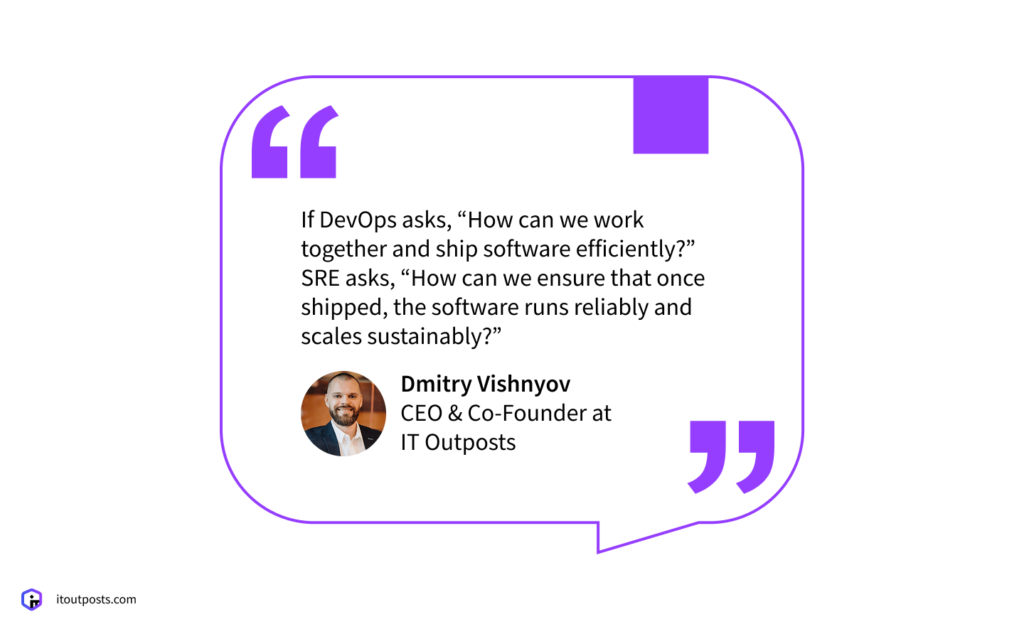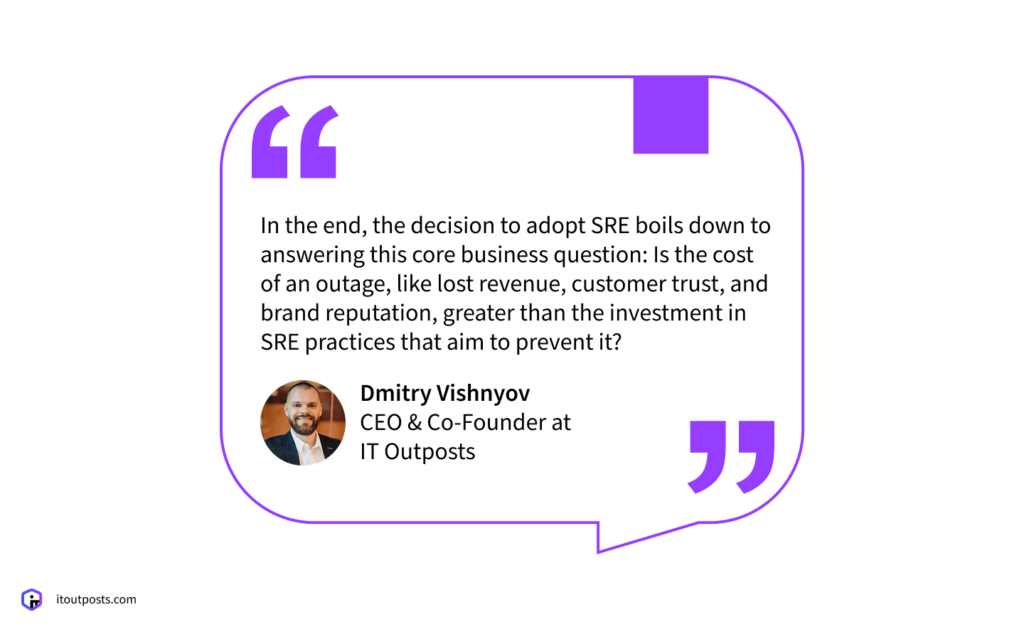Contents
Have you thought about how tech companies keep their websites and apps performing seamlessly, even during frequent deployments and when there is a surge in user activity? Consider how Netflix remains operational during major show launches.
A variety of factors contribute to this: robust infrastructure design with automated deployment pipelines, sophisticated monitoring systems, comprehensive disaster recovery plans, and more. And Site Reliability Engineering (SRE) is the umbrella approach, the framework that helps you bring all these pieces together and make them work as a single system to ensure your software reliability.
In this article, we share how adopting this approach could enhance the operations in your company, and how to determine whether SRE is actually worth your investment.
What Is SRE?
Under the SRE framework, difficulties in operations are viewed as challenges that can and should be solved using automation and code.
In other words, while the actual issues are operational (servers crashing, network problems, saturated databases), SRE teams treat them as software engineering problems with the following questions in mind:
- How do we detect an issue in code?
- How do we fix or mitigate an issue automatically via software?
- How do we measure and keep the system within safe and reliable bounds on autopilot?
For instance, SRE engineers don’t restart a broken server manually, but design an automated system capable of restarting the server on its own once failure is detected.
Ultimately, SRE aims for a system to achieve such a high degree of resilience that it’s able to self-repair from the most common issues, allowing engineers to devote their efforts to initiatives that provide greater value for businesses.
How SRE Complements DevOps
DevOps is a set of principles and practices that encourage development and operations teams to collaborate closely to speed up the development and delivery of software and enhance the quality of the product.
However, speed achieved with the help of DevOps requires extra safety measures; with increased agility and frequent changes, it becomes difficult to maintain the control and reliability of the systems. That is the point where SRE’s role begins. It complements DevOps by ensuring that software not only gets delivered quickly but also operates reliably in production.
If DevOps asks, “How can we work together and ship software efficiently?” SRE asks, “How can we ensure that once shipped, the software runs reliably and scales sustainably?”

3 Key Service Reliability Metrics: SLI, SLO, SLA
To answer the SRE question, the main focus should be on determining the specific objectives for system reliability, monitoring performance against those objectives, and taking the needed performance compliance actions if system reliability targets are not met. That’s where SLI, SLO, and SLA come into play.
SLI
SLI (Service Level Indicator) is the metric that measures how a service is performing. SLIs track quantitative aspects of the service such as latency, error rate, availability, or throughput. They are the actual data points that tell you how well the system is working in real time.
SLO
SLO (Service Level Objective) refers to the target set for one or more SLIs. An SLO defines the acceptable level of service performance over a specified period. For example, an SLO might specify that 99.9% of requests must succeed within 200 milliseconds over a month.
SLA
SLA (Service Level Agreement) is a documented promise, often contractual, given between a service provider and its customers. It outlines the minimum reliability standards the service will meet and defines what remedial actions will be taken when these targets are not achieved.
The SLA might state that critical issues will be resolved within 24 hours of being reported. If the team fails to meet this deadline, the provider might be obligated to offer service credits or refunds to affected customers.
For example, Amazon Web Services (AWS) provides a 99.99% uptime guarantee for certain services, such as Secret Manager, meaning it would be available for at least this percentage of time within a monthly billing cycle.

What Makes SRE Actually Work in Practice
The proper infrastructure and processes must be implemented for SRE to be effective. The following factors will determine whether your SRE initiatives are successful.
Modern Infrastructure Without Hard Limits
Reliable systems are constrained by the infrastructure in place. SRE most effectively supports projects that have been modernized to remove hard limits, such as legacy infrastructure with a single point of failure. The impact of SRE practices will be much greater when paired with a flexible modern architecture.
Monitoring
“An ounce of prevention is worth a pound of cure” is the core principle of SRE, as it aims to predict and prevent software issues in the first place, before they impact users. That’s where monitoring tools come in handy, tracking your previously established SLIs and alerting your team in case of significant deviations from your SLOs.
Disaster Recovery Planning and Resilience Testing
Another principle of SRE is that the reliability of systems should not be aimed at reaching 100%. There should always be a rational risk-taking approach. This is what makes disaster recovery planning a critical part of an SRE strategy.
A disaster recovery plan is your step-by-step guide for coming back online after major failures, whether that be server failures, data center outages, or cyberattacks. It describes who is responsible for what, what backup systems need to be activated, and how to restore services in the fastest way possible.
In addition, such plans must be regularly tested, as software projects aren’t static: traffic increases, so does the amount of customer data, new services are released, new integrations are added. Thus, the assumptions that have been made in the past need to be verified and the plan adjusted accordingly.
Learning from Every Incident
And when issues do happen, SRE engineers also conduct blameless post-mortem sessions to learn lessons from their mistakes and prevent similar problems in the future. This allows for building a shared knowledge base that strengthens their approach.
Is SRE Right for Your Business? The Feasibility Question
Not every business is immediately ready for a full SRE implementation. It’s an investment that only delivers its full value when certain foundations are in place. Before you ask if you can afford SRE, a better question is whether your business is structured to truly benefit from it.
Modern Infrastructure: The Foundation
As we’ve already mentioned, SRE works best when there is a modern, flexible infrastructure. This means systems built on a cloud-native architecture, using microservices and leveraging containerization.
Such infrastructure allows SRE teams to implement automated deployments, scale resources on demand, and much more.
Aligning SRE with Business Goals
The next step is making sure that your decision to adopt SRE is aligned with the key objectives of the company. SRE is mostly important for businesses when:
- You plan to scale the company significantly. If your company is planning to enter into a new industry, waiting for a surge in users, or is planning to roll out a new offering, SRE is handy in providing scaling to the infrastructure without any failures.
- Your customer experience is a competitive advantage. For businesses like streaming services, e-commerce platforms, or SaaS companies, a seamless user experience is the product itself. SRE directly protects this by prioritizing uptime and performance.
- You operate in a regulated or high-stakes industry. If your business handles sensitive data or operates under strict regulations, you can’t afford outages and unexpected downtime. SRE provides a systematic approach to keep your systems secure and compliant.

How the Investment in SRE Pays Off
The return on your SRE investment isn’t always a straightforward, immediate financial gain. Rather, it’s achieved by preventing losses and opening new opportunities for growth. The investment typically recoups in the following ways:
- Avoiding service interruptions. Your business loses money when your systems are down. SRE’s emphasis on preventing failures and recovering promptly from them protects your revenue. The cost of lost sales, damaged reputation, and recovery efforts from a system outage often far exceeds the investment in an SRE team.
- Fostering customer trust. Customers tend to stay longer and recommend your brand to others when your services are quick and available. This value, though difficult to measure, is critical, and SRE works to both enhance and safeguard it.
- Enabling faster innovation. Without SRE, every new feature or update carries more risks of breaking your system, which often makes teams cautious and slow. With SRE, in contrast, you have much more confidence to move faster, as you know exactly how much risk you can afford to take.
In the end, the decision to adopt SRE boils down to answering this core business question: Is the cost of an outage, like lost revenue, customer trust, and brand reputation, greater than the investment in SRE practices that aim to prevent it?

AMIX Infra: Your First Step to Reliable App Performance
Some companies try to use SRE practices on old infrastructure that is set up poorly, outdated, or lacks the automation and monitoring capabilities that effective SRE practices demand.
With AMIX infra, you no longer need to deal with these problems. AMIX is designed based on industry and compliance standards and offers an all-in-one package with over 20 DevOps tools. It includes monitoring systems like Prometheus and Grafana, security tools, container orchestration with Kubernetes, and many more.
Get AMIX at no cost and start building your DevOps processes correctly, while the IT Outposts team is always ready to support you along the way.

I am an IT professional with over 10 years of experience. My career trajectory is closely tied to strategic business development, sales expansion, and the structuring of marketing strategies.
Throughout my journey, I have successfully executed and applied numerous strategic approaches that have driven business growth and fortified competitive positions. An integral part of my experience lies in effective business process management, which, in turn, facilitated the adept coordination of cross-functional teams and the attainment of remarkable outcomes.
I take pride in my contributions to the IT sector’s advancement and look forward to exchanging experiences and ideas with professionals who share my passion for innovation and success.